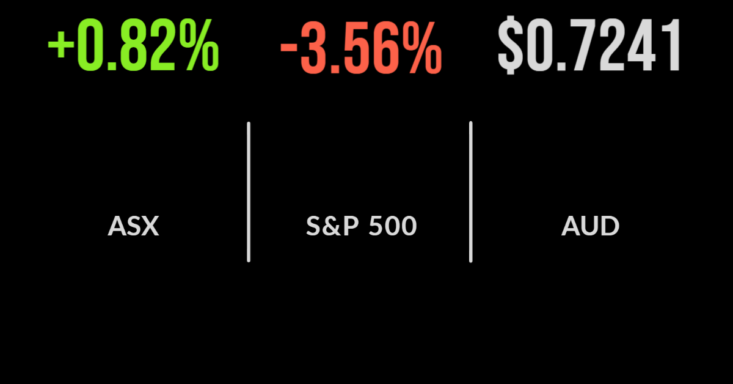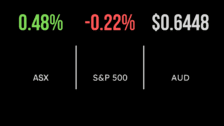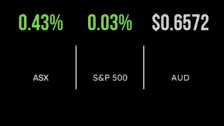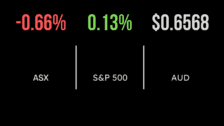Mining and energy boost market
The Australian share market followed Wall Street on Thursday, sharing the American market’s optimism that the Federal Reserve could tame inflation without triggering a recession.
The benchmark S&P/ASX 200 index finished Thursday up 60 points, or 0.8 per cent, to 7,364.7, while the broader S&P/All Ordinaries gauge rose 74.4 points, or just under 1 per cent, to 7,639.2.
Every sector finished in the green except for financials, which were flat as three of the big banks and Macquarie Group lost ground.
Westpac was down 6 cents to $24.01, ANZ down 47 cents to $26.91, NAB eased 19 cents to $32.25, and Macquarie closed $2.07 lower at $202.66.
But CBA bucked the financials trend, up 73 cents to $103.71. Global insurer QBE improved 5.5 per cent to $12.68 after announcing that its gross written premium rose 19 per cent in the first quarter, compared to a year ago.
Old King Coal in the pink of health
The energy and materials sectors had good days, rising 2.0 and 1.5 per cent, respectively. The energy names were led by the coal producers, with Whitehaven Coal jumping 20 cents, or 4.1 per cent, to $5.07.
New Hope Corporation closing up 19 cents, or 5.4 per cent, to $3.72; and Yancoal surged 39 cents, or 7.4 per cent, to $5.66.
Woodside Petroleum gained 68 cents, or 2.2 per cent, to $31.82, while Santos added 11 cents, or 1.4 per cent, to $8.18.
Among the miners, iron ore producer Fortescue Metals added 71 cents, or 3.5 per cent, to $20.83; BHP gained 5 cents to $47.45 and Rio Tinto advanced 47 cents, or 0.4 per cent, to $111.58.
Lithium producers Liontown Resources and Pilbara Minerals were on a tear: Liontown jumped 11 cents, or 7.7 per cent, to $1.46: the stock has gained 250 per cent in a year, as lithium prices have soared.
Pilbara Minerals gained 20 cents, or 7.6 per cent, to $2.83.
Elsewhere, African-based uranium miner, Paladin Energy was up 5 cents, or 6.5 per cent, to 82 cents.
Among the losers for the day, global funds manager Janus Henderson plunged $5.66, or 13 per cent, to a three-month low of $37.76, after reporting that assets under management dropped 8 per cent during the March quarter.
Health and beauty products company BWX also had a day to forget, slumping 38 cents, or 20.6 per cent, to a three-year low of $1.48 after saying that recent acquisitions and investments in people and marketing had not yet flowed through into revenue growth.
A highlight for the day came in the foreign exchange market, where the Australian dollar posted its biggest daily gain in more than a decade, surging 2.2 per cent to 72.4 US cents.
Tech sell-off leads Wall Street reverse
After a positive session the previous day, the US markets dropped their bundle after the Bank of England warned of double-digit inflation and rising recession risk in the UK.
That, and some disappointing quarterly earnings reports, triggered a tech sell-off, with Facebook’s parent Meta Platforms falling 6.8 per cent, Amazon losing 7.6 per cent, Microsoft surrendering 4.4 per cent, Salesforce slumping 7.1 per cent, and Apple losing 5.6 per cent. Afterpay’s new owner, Block. Inc., lost 10.5 per cent.
The tech-heavy Nasdaq Composite index ended the day with a 5 per cent loss, to finish at 12,317.69, its lowest closing level since November 2020.
It was the Nasdaq’s worst single-day drop since 2020, and the 30-stock Dow Jones Industrial Average recorded the same stat, losing 1,063 points, or 3.1 per cent, to close at 32,997.97.
The broader S&P 500 Index lost 3.56% to 4,146.87, marking its second-worst day of the year.
On the bond market, a sell-off in long-end Treasuries pushed yields to fresh multi-year highs overnight, with the benchmark 10-year rate pushing well beyond the 3 per cent threshold that has been tested for four straight trading sessions.
The yield on the US 30-year bond rose 17 basis points to a peak above 3.2 per cent, its highest level since December 2018.
The Australian dollar is buying 71 US cents this morning.











